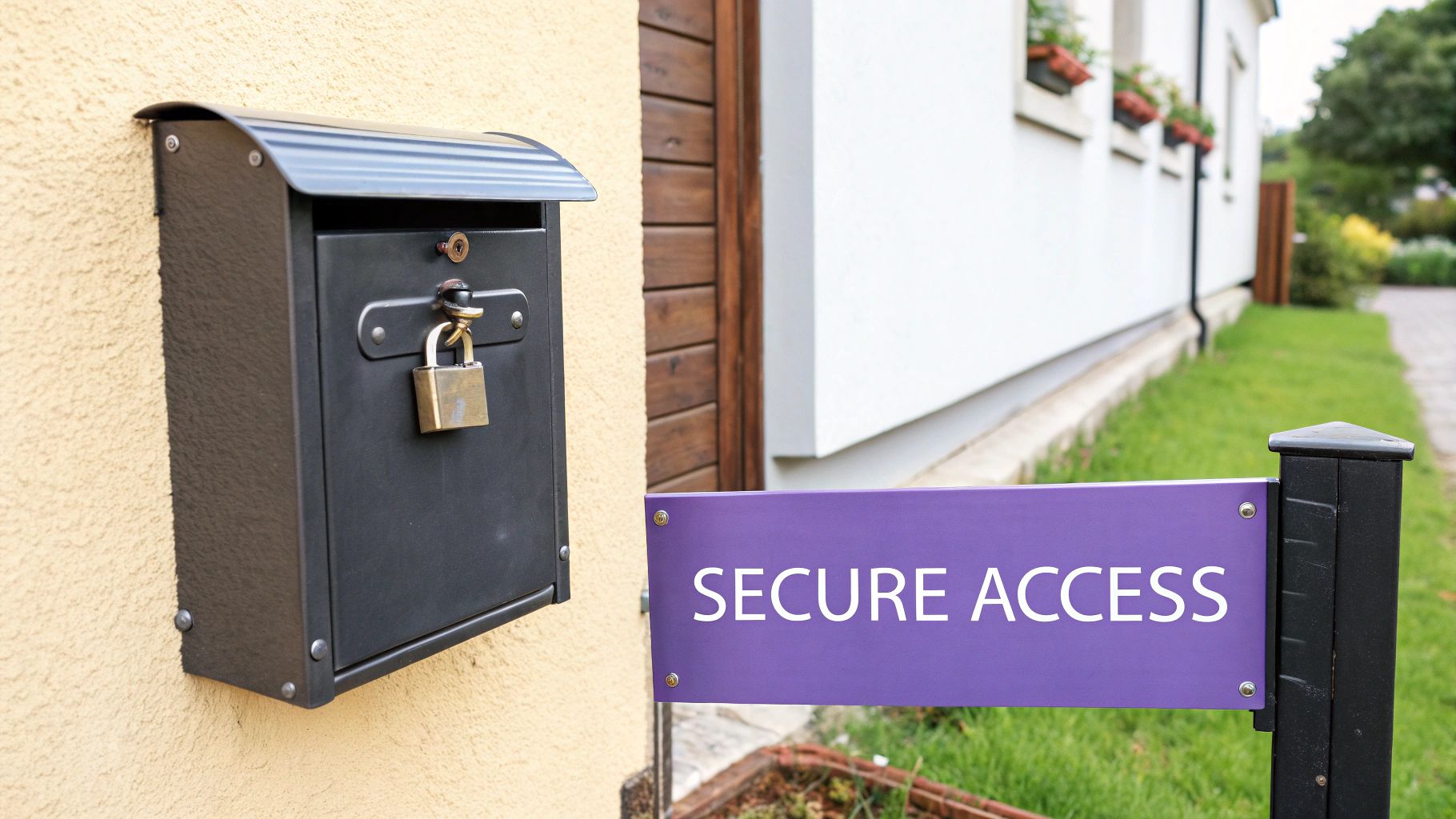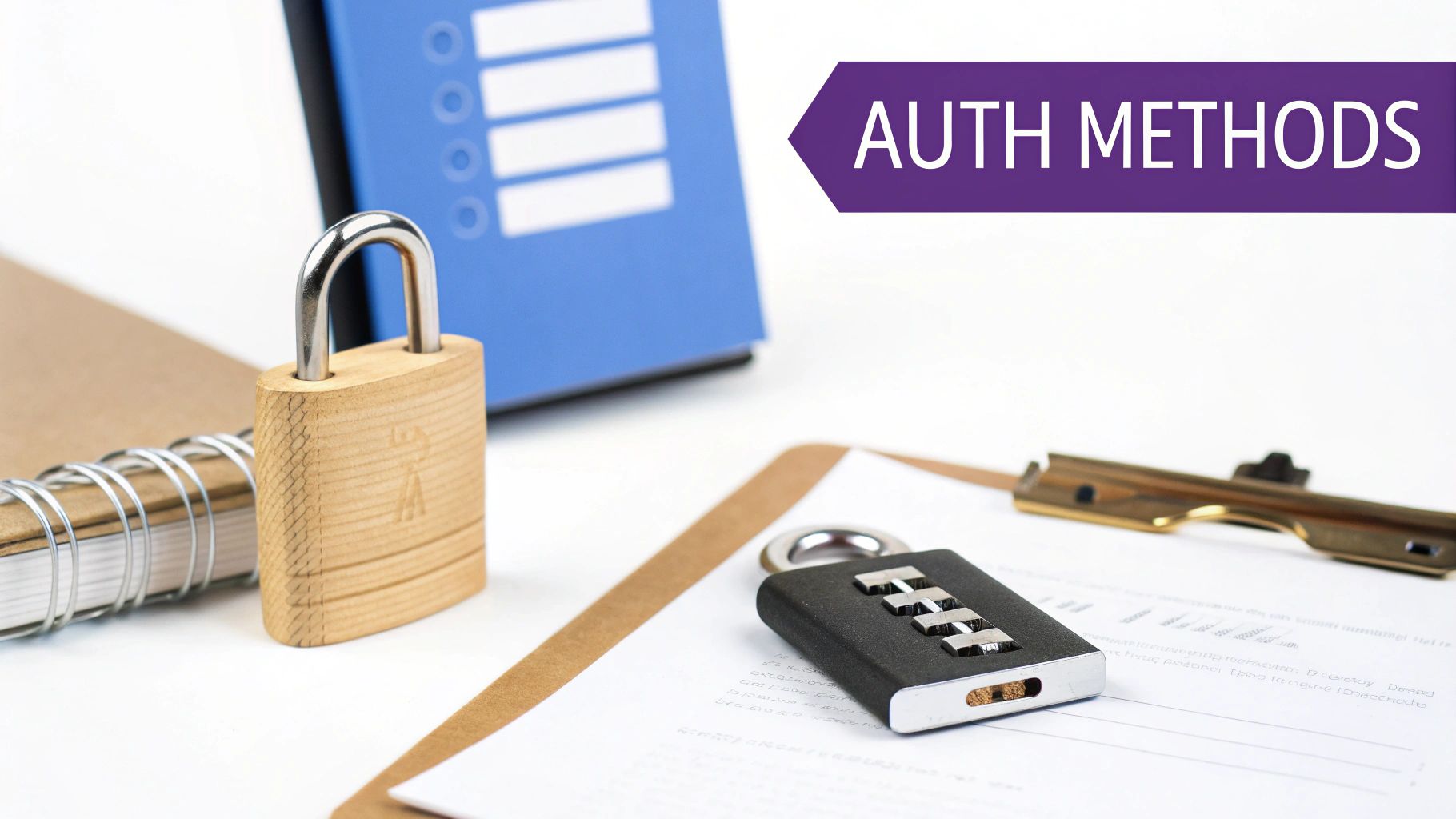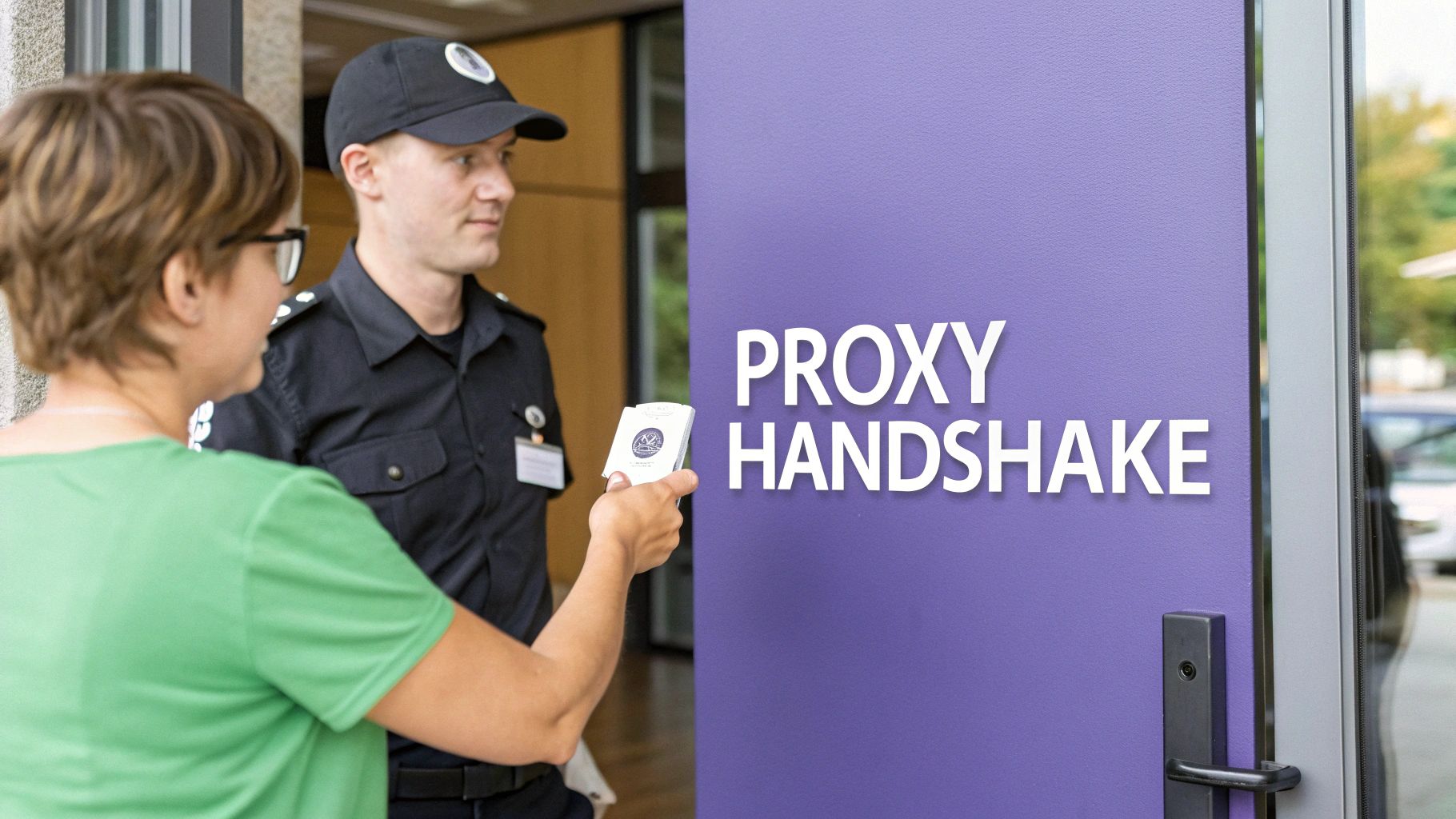Think of a proxy server as a personal courier for your internet traffic. It's the middleman that forwards your requests to websites and brings their responses back to you, often adding a layer of anonymity or letting you sidestep geo-blocks. But what stops someone else from using your courier?
That's where proxy server authentication steps in. It's the digital bouncer that checks your ID before letting you use the service, ensuring only authorized users get access.
Understanding the Core Concept of Proxy Authentication
Proxy authentication is the security check that happens before you're allowed to use a proxy server. It's a digital gatekeeper, and it usually asks for a simple username and password or verifies that your request is coming from a pre-approved IP address. This process makes sure only authorized users can route their traffic through the server.

Without it, anyone on the internet could potentially use your proxy. This could burn through your bandwidth, expose you to security risks, or even get your server's IP address blacklisted if someone uses it for malicious activities.
The Locked Mailbox Analogy
To really get a handle on this, let's use an analogy. Imagine your proxy server is a locked mailbox at a post office. It’s there specifically to handle your mail (your data).
- The Mailbox: This is the proxy server itself—a private, dedicated box for your web traffic.
- The Key: These are your credentials. It could be a username and password or an IP address that's on the "approved" list.
- The Action: Using the key to unlock the box is the authentication process. It proves you're the rightful owner.
If there's no lock and key, the mailbox is just a public bin. Anyone can drop things in or rifle through what's inside. But with a key, it becomes a secure, private resource reserved just for you.
Actionable Insight: A proxy without authentication is like a public bench in a park—anyone can use it, and you have no control over who sits there or what they do. An authenticated proxy is like a private office—only authorized individuals with a key card can enter, ensuring security, accountability, and controlled access. Always choose authenticated proxies for any task that requires reliability or security.
Why Authentication Is Non-Negotiable
Setting up proxy server authentication isn't just a "nice-to-have" feature; it's a fundamental security requirement. It’s your first line of defense against unauthorized access, protecting your data and keeping your network operations clean. An open, unauthenticated proxy is simply an open invitation for abuse.
By forcing users to prove who they are, you establish a clear line of accountability. This one step transforms a wide-open gateway into a secure, managed, and reliable asset. It's the most critical move you can make when setting up a proxy for any serious task, from secure browsing to large-scale data scraping.
Authenticated vs. Unauthenticated Proxies at a Glance
To put it all together, let's quickly break down the key differences. This table shows why that "lock and key" is so important.
| Feature | Authenticated Proxy (Secure) | Unauthenticated Proxy (Open) |
|---|---|---|
| Access Control | Restricted to authorized users with credentials. | Open to anyone who knows the server address and port. |
| Security | High. Prevents unauthorized use and abuse. | Extremely low. Prone to hijacking and malicious activity. |
| Accountability | High. User activity can be logged and traced. | None. Impossible to track who is using the proxy. |
| Resource Management | Controlled. Prevents bandwidth and resource draining. | Uncontrolled. Anyone can consume your resources. |
| Use Case | Secure browsing, data scraping, account management. | Not recommended for any serious or secure task. |
Actionable Insight: When choosing a proxy provider, confirm that they offer robust authentication options. If you find a "free" proxy list online, it almost certainly consists of unauthenticated proxies, which are unsafe for any purpose beyond casual, low-stakes browsing.
Exploring Core Authentication Methods
Once you understand why authentication matters, the next step is to explore how it's done. Securing a proxy server isn't a one-size-fits-all task; different situations demand different kinds of locks. Let's unpack the most common methods, starting with the simple and working our way up to more bulletproof solutions.
Think of it like securing a private clubhouse. You could use a simple password whispered at the door, a secret handshake, or a strict, members-only guest list that checks IDs at the entrance. Each approach offers a unique balance of security and convenience.

Basic Authentication: The Simple Lock and Key
The most straightforward method is Basic Authentication. It works exactly like you'd expect—you provide a username and password, and if they match what the server has on file, you're in.
Practical Example: Many proxy providers will give you credentials like user123 and pass456. When you configure your browser or script, you'll input these details directly. It’s popular because it’s incredibly easy to set up. But its simplicity comes with a major catch: the credentials are sent over the network with only a light layer of encoding (Base64), which is trivial to reverse.
Actionable Insight: Basic Authentication is like writing your password on a postcard and mailing it. Anyone who intercepts the mail can read it. For this reason, it should only ever be used over an encrypted connection (like HTTPS or with a SOCKS5 proxy) to shield the credentials in transit.
Digest Authentication: The Scrambled Secret
A much safer alternative is Digest Authentication. Instead of sending your credentials in a nearly plain-text format, this method uses a clever challenge-response system.
Here’s a practical breakdown of how it works:
- Your client tries to connect to the proxy.
- The proxy server sends back a unique, one-time value called a "nonce" (just a random string).
- Your client takes your username, password, the nonce, and a few other details, then mashes them all together into a unique, scrambled value known as a hash.
- This hash—not your actual password—is sent back to the server.
The server runs the exact same calculation on its end. If the two hashes match, access is granted. This is a huge security upgrade because your actual password never travels across the network. It's like proving you know a secret handshake without performing it in public for everyone to see.
IP Whitelisting: The Exclusive Guest List
Moving away from passwords entirely, IP Whitelisting (or IP authentication) offers a completely different approach. This method grants access based on where a request is coming from, not who is making it.
Practical Example: In your proxy provider’s dashboard, you would navigate to a section for "IP Authorization" or "Whitelisted IPs." You would then enter the static IP address of your office or server (e.g., 203.0.113.10). The provider's system will then automatically allow any traffic from that IP to use the proxy without asking for a password.
This is a fantastic method for environments where you have a static, known IP address, like an office network or a dedicated server. The only downside is that it’s impractical for anyone with a dynamic IP address that changes frequently.
Modern Authentication: Sophisticated Approaches
As the proxy server market continues to grow—valued at USD 3.4 billion in 2023 and projected to hit USD 7.2 billion by 2031—the demand for even more secure methods has skyrocketed. While techniques like Basic and Digest are still widely used, modern applications often require something more robust.
When you're exploring these tougher authentication options, advanced methods such as Multi-Factor Authentication (MFA) add another critical layer of security. This approach requires users to provide two or more verification factors to gain access, drastically cutting the risk of unauthorized use. For businesses handling sensitive data, combining IP whitelisting with another factor creates an incredibly powerful security posture.
How Proxy Authentication Works Step by Step
Ever wondered what really happens when you connect to a secure proxy? It’s not just a single connection; it's a rapid-fire technical "handshake" between your device and the server. This sequence is the core of proxy server authentication, and it’s what confirms your identity before letting you out onto the open internet.
Let's break it down with a simple analogy. Think of it like trying to get into an exclusive, members-only club.

You (your browser or app) stroll up to the front door (the proxy server). The bouncer (the proxy) immediately puts a hand up and asks for your membership card (your credentials). This whole exchange happens in milliseconds, but it always follows a structured, three-part cycle.
Step 1: The Initial Request
Your journey starts the moment your client—whether it's Chrome, a custom script, or an application—sends its first request to the proxy. It’s trying to reach a target website, like https://example.com, but at this stage, it hasn't presented any credentials at all.
This is you confidently walking up to the club's entrance. You haven't shown your ID yet; you're just making your presence known and showing you want in.
Step 2: The Challenge – A 407 Response
Because the proxy is configured to be secure, it doesn't just wave the request through. Instead, it blocks it and sends back a very specific HTTP status code: 407 Proxy Authentication Required.
This response is the digital version of the bouncer saying, "Hold on, I need to see your ID before you go any further." The 407 response also helpfully includes details on what kind of authentication it will accept (e.g., Proxy-Authenticate: Basic).
Actionable Insight: The
407 Proxy Authentication Requiredstatus code is the key signal in this entire process. When troubleshooting, seeing a 407 error instantly tells you the problem is with your proxy credentials, not the destination website. Check your username, password, or whitelisted IP.
This step is precisely what separates a secure proxy from a wide-open one. An open proxy would have just forwarded your request without a challenge, leaving the connection exposed to anyone.
Step 3: The Response and Verification
After receiving the 407 challenge, your client knows exactly what to do. It automatically re-sends the original request, but this time, it adds a crucial piece of information: the Proxy-Authorization header. This header contains your credentials, formatted correctly for the required authentication method (for example, a Base64-encoded username and password for Basic auth).
This is you reaching into your wallet, pulling out your membership card, and handing it to the bouncer. The proxy server gets this new request and performs the final check:
- Credential Extraction: The server pulls the credentials from the
Proxy-Authorizationheader. - Validation: It checks these credentials against its internal list of approved users.
- Decision: If they match, access is granted. The proxy forwards your request to the target website. If they don't match, it sends another 407 response, and the connection fails.
Once you're verified, the bouncer nods and opens the door. You're in. This entire request-challenge-response cycle ensures every single connection is deliberately and securely verified.
Putting Authentication Into Practice
Theory is great, but seeing authentication work in your own code is what really matters. This section provides hands-on, copy-paste-ready code examples to get you started immediately, whether you're building a web scraper or configuring a browser extension.
We’ll walk through how to implement proxy server authentication for common tasks using popular programming languages.

Formatting Proxy URLs with Credentials
Before diving into code, you need to understand the standard URL format for embedding authentication details. This structure is universally recognized by most tools and scripts.
The format is: protocol://username:password@proxy_host:proxy_port
Let's break that down:
- protocol:
httporhttps(orsocks5for SOCKS proxies). - username:password@: Your login details, separated by a colon, followed by the
@symbol. - proxy_host:proxy_port: The IP address or hostname of the proxy and its port.
Practical Example: If your username is user123, password is pass456, and the proxy is proxyserver.com:8080, your full authenticated URL would be http://user123:pass456@proxyserver.com:8080.
Practical Python Example with the Requests Library
Python's requests library is the gold standard for HTTP tasks and handles proxy authentication elegantly. You don't have to build the URL string by hand; instead, you pass your credentials in a clean dictionary.
Here’s an actionable script to test your proxy:
import requests
# Your proxy server details
proxy_ip = "proxyserver.com"
proxy_port = 8080
proxy_user = "user123"
proxy_pass = "pass456"
# The target website to verify your IP
target_url = "https://httpbin.org/ip"
# Construct the proxies dictionary
proxies = {
"http": f"http://{proxy_user}:{proxy_pass}@{proxy_ip}:{proxy_port}",
"https": f"http://{proxy_user}:{proxy_pass}@{proxy_ip}:{proxy_port}",
}
try:
# Make the request using the proxies with a timeout
response = requests.get(target_url, proxies=proxies, timeout=10)
response.raise_for_status() # Raise an exception for bad status codes (4xx or 5xx)
# Print the IP address returned by the website
print("Request sent successfully through proxy IP:", response.json()['origin'])
except requests.exceptions.ProxyError as e:
print(f"Failed to connect to the proxy. Check your host, port, and credentials. Error: {e}")
except requests.exceptions.RequestException as e:
print(f"An error occurred: {e}")
Actionable Insight: The
proxiesdictionary is a best practice. It separates your credentials from your core logic, making it easy to swap proxy configurations without touching the main request code. Thetimeoutandraise_for_status()are crucial for building robust, production-ready scripts.
JavaScript Example Using Node-Fetch
For JavaScript developers in a Node.js environment, node-fetch requires a custom agent like https-proxy-agent to handle authentication.
First, install the necessary packages:npm install node-fetch https-proxy-agent
Next, here's a practical script:
import fetch from 'node-fetch';
import { HttpsProxyAgent } from 'https-proxy-agent';
// Your proxy server details and credentials
const proxyUrl = 'http://user123:pass456@proxyserver.com:8080';
// The URL you want to fetch
const targetUrl = 'https://httpbin.org/ip';
// Create a new proxy agent with your URL
const proxyAgent = new HttpsProxyAgent(proxyUrl);
// Make the fetch request using the agent
async function testProxy() {
try {
const response = await fetch(targetUrl, { agent: proxyAgent });
if (!response.ok) {
throw new Error(`HTTP error! status: ${response.status}`);
}
const data = await response.json();
console.log('Request sent successfully through proxy IP:', data.origin);
} catch (error) {
console.error('Failed to fetch:', error);
console.log('Actionable Tip: Check if your proxy URL, username, and password are correct. Also, ensure the proxy server is running.');
}
}
testProxy();
In this example, HttpsProxyAgent acts as the middleman, taking your authenticated proxy URL and ensuring node-fetch routes its request through it correctly. This is fundamental for applications that need to manage outgoing connections securely, such as those downloading URLs as files.
Why This Matters in a Connected World
Implementing proxy server authentication isn't just a technical box to check; it’s a crucial part of modern data operations. In 2024, there were over 4.2 billion internet users connecting indirectly via proxies, with an estimated 1.1 billion of those instances involving authenticated connections for tasks like IP rotation. What's more, about 78% of Fortune 500 companies rely on authenticated proxy networks to secure automated data gathering and protect their digital assets.
These numbers tell a clear story: authenticated proxies are the industry standard for secure, reliable, and accountable web interactions.
Choosing the Right Authentication Method
Picking the right proxy server authentication method isn’t about finding a single “best” option—it’s about matching the tool to the job. The ideal choice comes down to balancing security, convenience, and your technical setup.
Think of it like choosing a lock for a door. You wouldn't put a simple bedroom lock on a bank vault. Similarly, a solo developer’s side project has different security demands than a large company handling sensitive data.
Assessing Your Use Case
To start, ask yourself a few practical questions. Your answers will quickly point you toward the most logical strategy.
- What’s my security risk? For simple web scraping of public data, Basic Auth might be fine. For managing social media accounts or financial data, you need something stronger.
- How many users need access? Managing username/password pairs for a team of two is easy. For a team of two hundred, IP whitelisting a central office IP is far more manageable.
- What’s my technical environment? If your server has a static IP, IP whitelisting is a secure and convenient option. If you're working from a home connection with a dynamic IP, username/password is the only practical choice.
- Are automated services involved? For scripts and bots, authentication needs to be simple. IP-based or username/password authentication are ideal for automation.
Actionable Insight: Choosing your proxy authentication method is a strategic decision. Basic authentication is fine for low-risk, personal projects. For business operations involving sensitive data, a more secure method like Digest authentication or IP whitelisting is non-negotiable.
Matching the Method to the Mission
Let's see how this logic plays out in a few real-world scenarios.
A solo developer building a small web scraper can probably get by just fine with Basic authentication. It’s quick to set up and provides a good enough layer of protection for a low-risk personal tool. For projects that grow, our guide to datacenter proxies can help you find reliable options that pair well with this method.
Now, consider a small business that handles customer information. They should immediately level up to Digest authentication. This simple switch stops passwords from being sent in a reversible format, giving them a major security boost without a ton of extra work. If that business operates from a single office with a static IP, IP whitelisting is an even smarter choice—it gets rid of password management altogether for anyone working on-site.
Finally, imagine a large-scale enterprise running automated data analysis from a fleet of dedicated servers. In this case, a solid IP whitelisting strategy is almost always the answer. It delivers top-tier security and makes access seamless for automated systems that can't handle traditional logins.
Getting this decision right is more important than ever. The global proxy market is projected to skyrocket from around USD 2 billion in 2025 to roughly USD 6 billion by 2033, a clear sign that secure and private internet access is becoming critical across every industry.
Frequently Asked Questions About Proxy Authentication
Even after you get the hang of proxy servers, a few common questions always seem to pop up. Here are actionable answers to the most frequent ones.
Proxy Password vs. Website Password: What's the Difference?
This is a crucial distinction for security. Think of it like this: you have one key for your office building's front door and another key for your personal office inside. They open different doors.
- A proxy password grants access to the proxy server. It's what you give your browser or script to get online through the proxy.
- A website password grants access to a website (like your email or social media) after you've already connected through the proxy.
Actionable Insight: Never reuse passwords between your proxy service and any website. If a website's database is breached, attackers could use your leaked password to access and abuse your proxy service, potentially running up costs or getting your IP blacklisted.
Can I Safely Use a Proxy Without Authentication?
In a word? No. Using an unauthenticated "open proxy" is asking for trouble. Because anyone on the internet can use them, they are a breeding ground for malicious activity.
Here are the practical risks:
- Security Threats: Scammers can use the open proxy to launch attacks, and the activity will be traced back to the proxy's IP address—which you are also using.
- Resource Drain: With everyone piling on, bandwidth gets gobbled up, slowing your connection to a crawl.
- Blacklisting: If someone uses the proxy for spamming, the IP will be blacklisted by major websites, making it useless for you.
Actionable Insight: An unauthenticated proxy is like a public Wi-Fi network with no password. Sure, it's convenient, but you're exposing yourself to unnecessary threats. For any serious work, authentication isn't optional—it's mandatory.
How Do I Fix a 407 Proxy Authentication Required Error?
Seeing a 407 Proxy Authentication Required error is your proxy server saying, "Hold on, you need to prove who you are." It's almost always a problem with your credentials.
Here’s a quick troubleshooting checklist:
- Check for Typos: The most common cause. Double-check your username, password, host, and port. A single wrong character will cause failure.
- Verify the URL Format: Ensure your proxy URL string is correct:
protocol://user:pass@host:port. Special characters in passwords often need to be URL-encoded. - Confirm the Auth Method: Is your client trying to use a method the server doesn't support? Check if the proxy expects Basic, Digest, or something else.
- Check Your Whitelisted IP: If using IP authentication, verify that your current public IP address is the one registered in your proxy provider's dashboard. A quick search for "what is my IP" will show you your current address.
Nine times out of ten, fixing a 407 error comes down to correcting how you're presenting your credentials to the server.
Is IP Whitelisting Better Than a Username and Password?
One isn't "better"—they're different tools for different jobs.
- Username and Password is best for flexibility. It lets authorized users connect from anywhere, on any device. Use Case: Perfect for remote teams, traveling employees, or anyone with a dynamic home IP address.
- IP Whitelisting is best for security in a fixed environment. It eliminates the risk of stolen passwords by tying access to a specific IP. Use Case: Ideal for automated scripts running on a server with a static IP or for securing access from a central office network.
Actionable Insight: For maximum security, use both. Many providers allow you to enable username/password authentication on top of a whitelisted IP. This means a request is only successful if it comes from an approved location and has the correct credentials. For a deeper dive, exploring a comprehensive proxy server FAQ can offer more insight.


